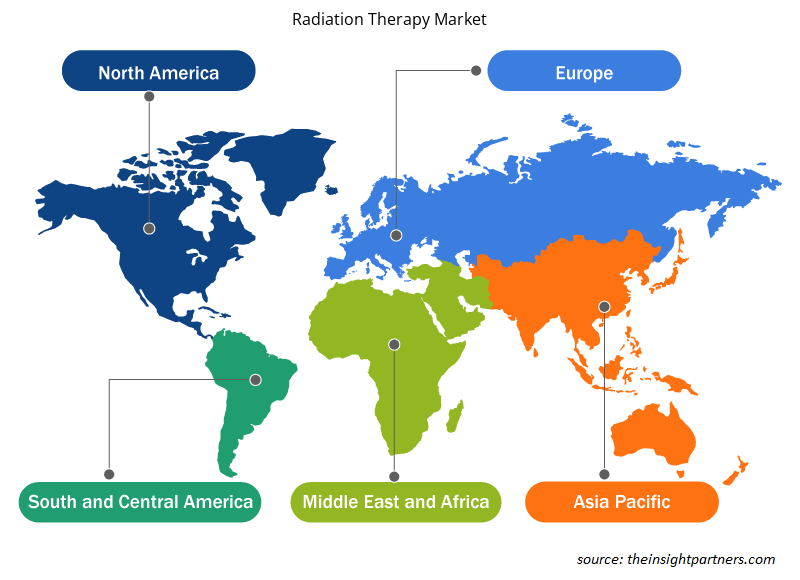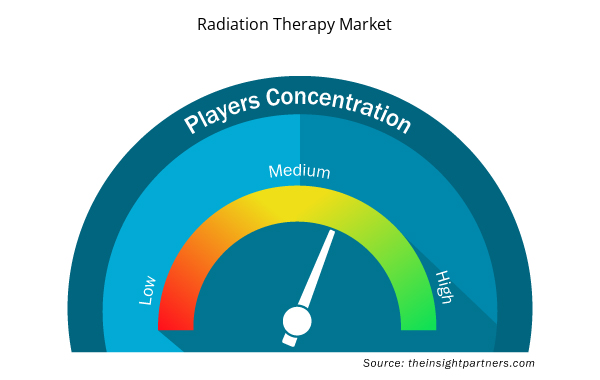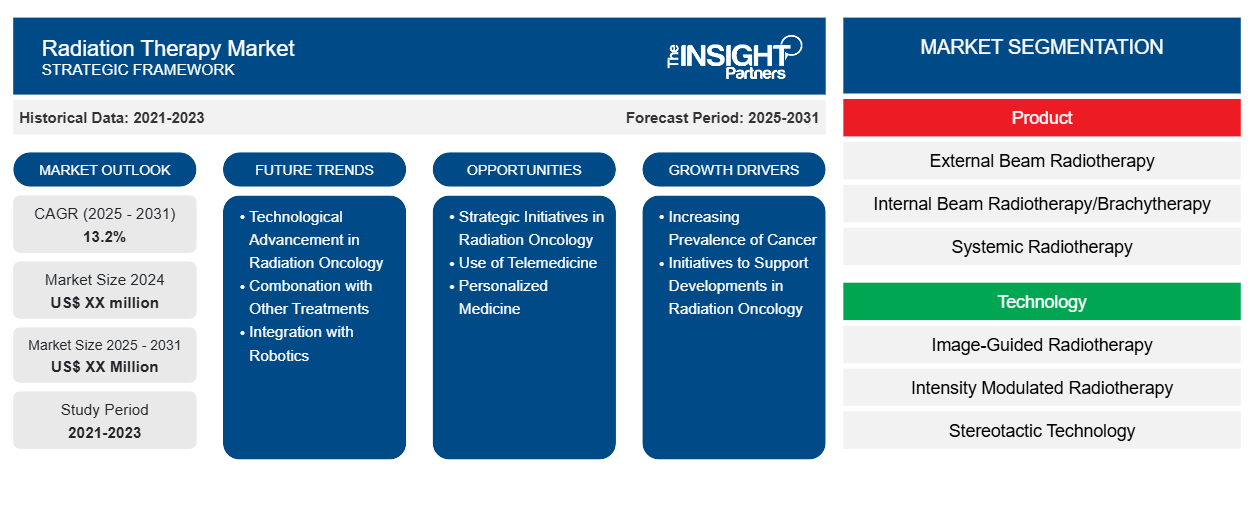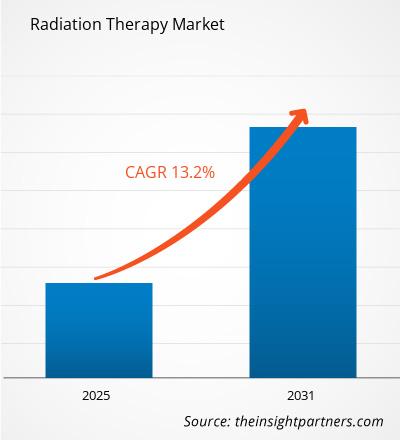Le marché de la radiothérapie devrait enregistrer un TCAC de 13,2 % de 2024 à 2031, avec une taille de marché passant de XX millions USD en 2024 à XX millions USD d'ici 2031.
Le rapport est segmenté par produit (radiothérapie externe, radiothérapie interne/curiethérapie et radiothérapie systémique). Le rapport présente en outre une analyse basée sur la technologie (radiothérapie guidée par l'image (IGRT), radiothérapie à modulation d'intensité (IMRT), technologie stéréotaxique, protonthérapie, radiothérapie conformationnelle 3D (3D CRT), thérapie par arc modulé volumétrique (VMAT) et autres). Le rapport est segmenté par application (cancer de la prostate, cancer du sein, cancer du poumon, cancer de la tête et du cou, cancer colorectal et autres cancers). Le rapport présente en outre une analyse basée sur l'utilisateur final (hôpitaux et centres de radiothérapie indépendants). L'analyse globale est ensuite décomposée au niveau régional et par principaux pays. Le rapport offre la valeur en USD pour l'analyse et les segments ci-dessus.
Objectif du rapport
Le rapport sur le marché de la radiothérapie de The Insight Partners vise à décrire le paysage actuel et la croissance future, les principaux facteurs moteurs, les défis et les opportunités. Cela fournira des informations à diverses parties prenantes commerciales, telles que :
- Fournisseurs/fabricants de technologie : pour comprendre l’évolution de la dynamique du marché et connaître les opportunités de croissance potentielles, leur permettant de prendre des décisions stratégiques éclairées.
- Investisseurs : Effectuer une analyse complète des tendances concernant le taux de croissance du marché, les projections financières du marché et les opportunités qui existent tout au long de la chaîne de valeur.
- Organismes de réglementation : Réglementer les politiques et surveiller les activités du marché dans le but de minimiser les abus, de préserver la confiance des investisseurs et de maintenir l’intégrité et la stabilité du marché.
Segmentation du marché de la radiothérapie
Produit
- Radiothérapie externe
- Radiothérapie interne/curiethérapie
- Radiothérapie systémique
Technologie
- Radiothérapie guidée par l'image
- Radiothérapie à intensité modulée
- Technologie stéréotaxique
- Thérapie par faisceau de protons
- Radiothérapie conformationnelle 3D
- Thérapie par arc modulé volumétrique
Application
- Cancer de la prostate
- Cancer du sein
- Cancer du poumon
- Cancer de la tête et du cou
- Cancer colorectal
- Autres cancers
Utilisateur final
- Hôpitaux et centres de radiothérapie indépendants
Personnalisez ce rapport en fonction de vos besoins
Vous bénéficierez d'une personnalisation gratuite de n'importe quel rapport, y compris de certaines parties de ce rapport, d'une analyse au niveau des pays, d'un pack de données Excel, ainsi que de superbes offres et réductions pour les start-ups et les universités.
- Obtenez les principales tendances clés du marché de ce rapport.Cet échantillon GRATUIT comprendra une analyse de données, allant des tendances du marché aux estimations et prévisions.
Facteurs de croissance du marché de la radiothérapie
- Prévalence croissante du cancer : Le cancer est l’un des problèmes de santé les plus courants qui ont un impact significatif sur la société dans le monde entier. Selon l’Organisation mondiale de la santé (OMS), le cancer est la principale cause de décès dans le monde, représentant 9,7 millions de décès et 20 millions de nouveaux cas de cancer en 2022 et il devrait atteindre environ 35 millions de nouveaux cas de cancer d’ici 2050. La radiothérapie peut être utilisée à tout moment du traitement et peut être associée à d’autres traitements tels que la chirurgie, la chimiothérapie, l’immunothérapie et autres.
- Initiatives visant à soutenir les progrès en radio-oncologie : Les gouvernements et les organisations mettent en place des missions et des programmes pour le traitement rapide et efficace du cancer grâce à la radiothérapie. En septembre 2023, l’Agence internationale de l’énergie atomique (AIEA) a annoncé l’initiative phare contre le cancer « Rays of Hope » pour le développement des infrastructures de radiothérapie. Dans les pays développés comme les États-Unis, l’Allemagne, le Royaume-Uni, la France et d’autres, presque tous les patients ont accès à la radiothérapie.
- Sensibiliser et mettre en œuvre des programmes de dépistage qui affectent le domaine de la radio-oncologie. Les programmes de dépistage de divers cancers, notamment les carcinomes du sein, du col de l'utérus et colorectaux, sont désormais plus répandus, ce qui permet un diagnostic et un début de traitement plus précoces. Les patients diagnostiqués à un stade précoce du cancer sont plus susceptibles d'être éligibles à la radiothérapie comme traitement principal ou adjuvant, ce qui améliore les résultats.
Tendances futures du marché de la radiothérapie
- Progrès technologique en radio-oncologie : la radiothérapie vise à détruire les cellules cancéreuses en épargnant au maximum les cellules saines, ce qui a été réalisé au fil du temps grâce aux progrès de la technologie d'imagerie comme l'imagerie par résonance magnétique (IRM), la tomodensitométrie (TDM), la tomographie par émission de positons (TEP) et d'autres. Ces technologies d'imagerie permettent d'identifier les cellules tumorales ainsi que leur position et leur taille exactes, ce qui a conduit au développement de la radiothérapie conformationnelle 3D.
- Association avec d’autres traitements : L’utilisation de la radiothérapie en association avec d’autres traitements améliore l’efficacité de l’ensemble du schéma thérapeutique tout en améliorant les résultats des soins prodigués aux patients atteints de cette maladie mortelle. Dans la plupart des cas, une approche multidisciplinaire permet de mieux contrôler la maladie tout en prévenant la résistance au traitement. L’administration simultanée de chimiothérapie et de radiothérapie a amélioré les effets combinés qui sont souvent bénéfiques pour certains types de cancers comme les cancers du poumon et du col de l’utérus. L’intégration avec d’autres traitements est une approche importante en oncologie contemporaine.
- Intégration avec la robotique : L’intégration de technologies assistées par robot combinées à l’intelligence artificielle dans la radiothérapie révolutionne le traitement du cancer. Cela améliore encore la précision, l’efficacité et les résultats pour les patients. Les systèmes robotisés comprennent notamment le CyberKnife, qui fournit une administration de radiations très précise à la tumeur, épargnant les tissus sains qui l’entourent, et le Versa HD. Les robots peuvent alors faciliter la radiothérapie adaptative où les plans de traitement peuvent changer en fonction des fluctuations de taille ou de localisation de la tumeur pendant la durée des traitements.
Opportunités du marché de la radiothérapie
- Initiatives stratégiques en radio-oncologie : L'évolution constante de la radiothérapie par les acteurs du marché en termes de développement de produits, d'innovation, de lancement de produits, d'approbation de produits, de fusion, d'acquisition et de partenariats, entre autres, devrait contribuer à la croissance du marché. En mai 2024, Elekta a lancé son dernier accélérateur linéaire (linac), Evo, un CT-Linac doté d'une nouvelle imagerie haute définition améliorée par l'IA, capable de fournir une radiothérapie adaptative hors ligne et en ligne ainsi que des traitements de radiothérapie standard améliorés guidés par l'image.
- Utilisation de la télémédecine : En améliorant l’accessibilité, l’efficacité et les résultats pour les patients, la télémédecine et la planification à distance révolutionnent la pratique de la radiothérapie. La télémédecine surmonte les obstacles liés à la distance et permet des consultations directes entre les radio-oncologues et les patients dans les zones rurales ou mal desservies sans nécessiter de déplacement. La planification à distance rationalise encore davantage le flux de travail, permettant des ajustements et des approbations rapides pour finalement réduire le temps entre le diagnostic et le traitement. L’accès à distance aux études d’imagerie aide les radiologues à examiner les examens et à renvoyer des commentaires aux radio-oncologues dans les plus brefs délais imaginables.
- Médecine personnalisée : La médecine personnalisée en radiothérapie repose sur les caractéristiques individuelles, les facteurs génétiques, moléculaires et cliniques du traitement des patients, optimisant la radiothérapie avec un minimum d'effets secondaires toxiques. Grâce à une imagerie plus fréquente, l'administration de radiations peut être modifiée en fonction de l'évolution de la tumeur au fil du temps.
Aperçu régional du marché de la radiothérapie
Les tendances et facteurs régionaux influençant le marché de la radiothérapie tout au long de la période de prévision ont été expliqués en détail par les analystes d’Insight Partners. Cette section traite également des segments et de la géographie du marché de la radiothérapie en Amérique du Nord, en Europe, en Asie-Pacifique, au Moyen-Orient et en Afrique, ainsi qu’en Amérique du Sud et en Amérique centrale.

- Obtenez les données régionales spécifiques au marché de la radiothérapie
Portée du rapport sur le marché de la radiothérapie
| Attribut de rapport | Détails |
|---|---|
| Taille du marché en 2024 | XX millions de dollars américains |
| Taille du marché d'ici 2031 | XX millions de dollars américains |
| Taux de croissance annuel composé mondial (2025-2031) | 13,2% |
| Données historiques | 2021-2023 |
| Période de prévision | 2025-2031 |
| Segments couverts | Par produit
|
| Régions et pays couverts | Amérique du Nord
|
| Leaders du marché et profils d'entreprises clés |
|
Densité des acteurs du marché de la radiothérapie : comprendre son impact sur la dynamique commerciale
Le marché de la radiothérapie connaît une croissance rapide, tirée par la demande croissante des utilisateurs finaux en raison de facteurs tels que l'évolution des préférences des consommateurs, les avancées technologiques et une plus grande sensibilisation aux avantages du produit. À mesure que la demande augmente, les entreprises élargissent leurs offres, innovent pour répondre aux besoins des consommateurs et capitalisent sur les tendances émergentes, ce qui alimente davantage la croissance du marché.
La densité des acteurs du marché fait référence à la répartition des entreprises ou des sociétés opérant sur un marché ou un secteur particulier. Elle indique le nombre de concurrents (acteurs du marché) présents sur un marché donné par rapport à sa taille ou à sa valeur marchande totale.
Les principales entreprises opérant sur le marché de la radiothérapie sont :
- Hitachi, Ltée;
- Nordion (Canada) Inc.
- Systèmes médicaux Mevion.
- Isoray Inc.
- BD
Avis de non-responsabilité : les sociétés répertoriées ci-dessus ne sont pas classées dans un ordre particulier.

- Obtenez un aperçu des principaux acteurs du marché de la radiothérapie
Principaux arguments de vente
- Couverture complète : Le rapport couvre de manière exhaustive l’analyse des produits, des services, des types et des utilisateurs finaux du marché de la radiothérapie, offrant un paysage holistique.
- Analyse d’experts : Le rapport est compilé sur la base d’une compréhension approfondie des experts et analystes du secteur.
- Informations à jour : Le rapport garantit la pertinence commerciale en raison de sa couverture des informations récentes et des tendances des données.
- Options de personnalisation : ce rapport peut être personnalisé pour répondre aux exigences spécifiques du client et s'adapter parfaitement aux stratégies commerciales.
Le rapport de recherche sur le marché de la radiothérapie peut donc aider à ouvrir la voie au décodage et à la compréhension du scénario de l’industrie et des perspectives de croissance. Bien qu’il puisse y avoir quelques préoccupations valables, les avantages globaux de ce rapport ont tendance à l’emporter sur les inconvénients.
- Analyse historique (2 ans), année de base, prévision (7 ans) avec TCAC
- Analyse PEST et SWO
- Taille du marché Valeur / Volume - Mondial, Régional, Pays
- Industrie et paysage concurrentiel
- Ensemble de données Excel



Report Coverage
Revenue forecast, Company Analysis, Industry landscape, Growth factors, and Trends

Segment Covered
This text is related
to segments covered.

Regional Scope
North America, Europe, Asia Pacific, Middle East & Africa, South & Central America

Country Scope
This text is related
to country scope.
Questions fréquemment posées
External Beam Radiation Therapy segment, by product, dominated the market in 2023.
The Radiation Therapy Market is estimated to witness a CAGR of 13.2% from 2023 to 2031
North America region dominated the Ophthalmic Lasers market in 2023.
Strategic initiative in radiation therapy act as a opportunity for growth of the market in forecast period.
The major factors driving the Radiation Therapy market are:
1. Increasing Prevalence of Cancer.
2.Initiatives to Support Developments in Radiation Oncology
Players operating in the market are Varian Medical Systems, Elekta AB, Accuray Inc, Ion Beam Applications, BD, Perspective Therapeutics, Nordion, and Mevion Medical Systems
Trends and growth analysis reports related to Life Sciences : READ MORE..
1. Hitachi, Ltd.;
2. Nordion (Canada) Inc.
3. Mevion Medical Systems.
4. Isoray Inc.
5. BD
6. IBA Worldwide
7. Accuray Incorporated
8. Elekta AB
9. Varian Medical Systems, Inc.
10. Panacea Medical Technologies Pvt. Ltd.
The Insight Partners performs research in 4 major stages: Data Collection & Secondary Research, Primary Research, Data Analysis and Data Triangulation & Final Review.
- Data Collection and Secondary Research:
As a market research and consulting firm operating from a decade, we have published and advised several client across the globe. First step for any study will start with an assessment of currently available data and insights from existing reports. Further, historical and current market information is collected from Investor Presentations, Annual Reports, SEC Filings, etc., and other information related to company’s performance and market positioning are gathered from Paid Databases (Factiva, Hoovers, and Reuters) and various other publications available in public domain.
Several associations trade associates, technical forums, institutes, societies and organization are accessed to gain technical as well as market related insights through their publications such as research papers, blogs and press releases related to the studies are referred to get cues about the market. Further, white papers, journals, magazines, and other news articles published in last 3 years are scrutinized and analyzed to understand the current market trends.
- Primary Research:
The primarily interview analysis comprise of data obtained from industry participants interview and answers to survey questions gathered by in-house primary team.
For primary research, interviews are conducted with industry experts/CEOs/Marketing Managers/VPs/Subject Matter Experts from both demand and supply side to get a 360-degree view of the market. The primary team conducts several interviews based on the complexity of the markets to understand the various market trends and dynamics which makes research more credible and precise.
A typical research interview fulfils the following functions:
- Provides first-hand information on the market size, market trends, growth trends, competitive landscape, and outlook
- Validates and strengthens in-house secondary research findings
- Develops the analysis team’s expertise and market understanding
Primary research involves email interactions and telephone interviews for each market, category, segment, and sub-segment across geographies. The participants who typically take part in such a process include, but are not limited to:
- Industry participants: VPs, business development managers, market intelligence managers and national sales managers
- Outside experts: Valuation experts, research analysts and key opinion leaders specializing in the electronics and semiconductor industry.
Below is the breakup of our primary respondents by company, designation, and region:

Once we receive the confirmation from primary research sources or primary respondents, we finalize the base year market estimation and forecast the data as per the macroeconomic and microeconomic factors assessed during data collection.
- Data Analysis:
Once data is validated through both secondary as well as primary respondents, we finalize the market estimations by hypothesis formulation and factor analysis at regional and country level.
- Macro-Economic Factor Analysis:
We analyse macroeconomic indicators such the gross domestic product (GDP), increase in the demand for goods and services across industries, technological advancement, regional economic growth, governmental policies, the influence of COVID-19, PEST analysis, and other aspects. This analysis aids in setting benchmarks for various nations/regions and approximating market splits. Additionally, the general trend of the aforementioned components aid in determining the market's development possibilities.
- Country Level Data:
Various factors that are especially aligned to the country are taken into account to determine the market size for a certain area and country, including the presence of vendors, such as headquarters and offices, the country's GDP, demand patterns, and industry growth. To comprehend the market dynamics for the nation, a number of growth variables, inhibitors, application areas, and current market trends are researched. The aforementioned elements aid in determining the country's overall market's growth potential.
- Company Profile:
The “Table of Contents” is formulated by listing and analyzing more than 25 - 30 companies operating in the market ecosystem across geographies. However, we profile only 10 companies as a standard practice in our syndicate reports. These 10 companies comprise leading, emerging, and regional players. Nonetheless, our analysis is not restricted to the 10 listed companies, we also analyze other companies present in the market to develop a holistic view and understand the prevailing trends. The “Company Profiles” section in the report covers key facts, business description, products & services, financial information, SWOT analysis, and key developments. The financial information presented is extracted from the annual reports and official documents of the publicly listed companies. Upon collecting the information for the sections of respective companies, we verify them via various primary sources and then compile the data in respective company profiles. The company level information helps us in deriving the base number as well as in forecasting the market size.
- Developing Base Number:
Aggregation of sales statistics (2020-2022) and macro-economic factor, and other secondary and primary research insights are utilized to arrive at base number and related market shares for 2022. The data gaps are identified in this step and relevant market data is analyzed, collected from paid primary interviews or databases. On finalizing the base year market size, forecasts are developed on the basis of macro-economic, industry and market growth factors and company level analysis.
- Data Triangulation and Final Review:
The market findings and base year market size calculations are validated from supply as well as demand side. Demand side validations are based on macro-economic factor analysis and benchmarks for respective regions and countries. In case of supply side validations, revenues of major companies are estimated (in case not available) based on industry benchmark, approximate number of employees, product portfolio, and primary interviews revenues are gathered. Further revenue from target product/service segment is assessed to avoid overshooting of market statistics. In case of heavy deviations between supply and demand side values, all thes steps are repeated to achieve synchronization.
We follow an iterative model, wherein we share our research findings with Subject Matter Experts (SME’s) and Key Opinion Leaders (KOLs) until consensus view of the market is not formulated – this model negates any drastic deviation in the opinions of experts. Only validated and universally acceptable research findings are quoted in our reports.
We have important check points that we use to validate our research findings – which we call – data triangulation, where we validate the information, we generate from secondary sources with primary interviews and then we re-validate with our internal data bases and Subject matter experts. This comprehensive model enables us to deliver high quality, reliable data in shortest possible time.


 Obtenez un échantillon gratuit pour ce rapport
Obtenez un échantillon gratuit pour ce rapport